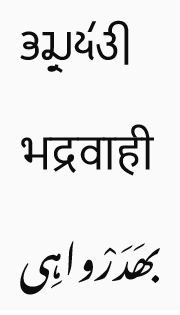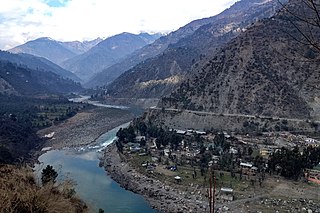Related Research Articles
Literature of Kashmir has a long history, the oldest texts having been composed in the Sanskrit language. Early names include Patanjali, the author of the Mahabhashya commentary on Pāṇini's grammar, suggested by some to have been the same to write the Hindu treatise known as the Yogasutra, and Dridhbala, who revised the Charaka Samhita of Ayurveda.

Kashmiri or Koshur is a language from the Dardic subgroup of Indo-Aryan languages, spoken by around 7 million Kashmiris, primarily in the Indian union territory of Jammu and Kashmir.
The Dardic languages are a subgroup of the Indo-Aryan languages natively spoken in northern Pakistan's Gilgit Baltistan and Khyber Pakhtunkhwa, Northern India's Kashmir Valley and Chenab Valley and parts of Eastern Afghanistan. Kashmiri is the most prominent Dardic language, with an established literary tradition; alongside official recognition as one of India's 22 scheduled languages.

Bhat, also spelled, by Muslims, as Butt, both of which are a shortened rendition of Bhatta, also spelled Bhatt, is a common surname in the Indian subcontinent. The Bhatta surname is associated with the Brahmin varna (caste) of Hinduism, however, large number of Muslims retained the surname after their conversion to Islam from Hinduism.
The Indo-Aryan language spoken on the Pothohar Plateau in the far north of Pakistani Punjab, as well as in most of Pakistan's Azad Kashmir and in western areas of India's Jammu and Kashmir, is known by a variety of names, the most common of which are Pahari and Pothwari.
The Western Pahari languages are a group of Northern Indo-Aryan languages spoken in the western parts of the Himalayan range, predominantly in the Indian state of Himachal Pradesh, but also in parts of Jammu and Uttarakhand.

Doda is a district in the eastern part of Jammu Division in the Indian union territory of Jammu and Kashmir. The district consists of 18 tehsils viz. Thathri, Bhaderwah, Doda, Mahalla, Bhagwa, Assar, Bhalla, Gundna, Marmat, Kahara, Gandoh (Bhalessa), Bhella, Bharth Bagla, Chiralla, Chilly Pingal, Phagsoo(Fagsu) and Kashtigarh.

Peerzada Ghulam Ahmad, known by his pen name as Mahjoor, was a poet of the Kashmir Valley, along with contemporaries, Zinda Kaul, Abdul Ahad Azad, and Dinanath Nadim. He is especially noted for introducing a new style into Kashmiri poetry and for expanding Kashmiri poetry into previously unexplored thematic realms. In addition to his poems in Kashmiri, Mahjoor is also noted for his poetic compositions in Persian and Urdu.

The Tākri script is an abugida writing system of the Brahmic family of scripts. It is derived from, the Sharada script formerly employed for Kashmiri. It is the sister script of Laṇḍā scripts. It is the parent script of Dogra Akkhar employed in Jammu region. Chambeali Takri was considered by Grierson as the standard form of Takri, primarily because it was the first variety that was developed for print. In addition to Chamba and Dogra, there are numerous varieties, “with each Hill State or tract having its own style.” Until the late 1940s, the adapted version of the script was the official script for writing Dogri in the princely state of Jammu and Kashmir and for Kangri, Chambyali and Mandyali in Himachal Pradesh. However, the Takri script used in the Sirmour in Himachal Pradesh and Jaunsar-Bhawar region in Garhwal hills has some distinction.
The major ethnic groups of Pakistan include Punjabis, Pashtuns, Sindhis, Saraikis, Muhajirs, Baloch, Paharis, Hindkowans,Rajputs and other smaller groups. Smaller ethnic groups found throughout the nation include Kashmiris, Kalash, Chitralis, Siddi, Burkusho, Wakhis, Khowar, Hazara, Shina, Kalyu Baltis and Jatts.

The culture of Kashmir is a diverse blend and highly influenced by Indian, Persian as well as Central Asian cultures. Kashmiri culture is heavily influenced by Hinduism, Buddhism and later by Islam. Dominated by Hindu-Buddhist culture in the past, Kashmir was heavily influenced by Islam after Muslim influx in the Valley.

Bhadarwahi is an Indo-Aryan language of the Western Pahari group spoken in the Bhadarwah region of Jammu and Kashmir, India.

Bhalesi is an Indo-Aryan language spoken in the Bhalessa region of Jammu and Kashmir, India. It is a member of the Bhadarwahi group of dialects and so falls under the Western Pahari sub-group of Indo-Aryan.

Padri is a dialect spoken in the Padar valley in Kishtwar district in the Indian territory of Jammu and Kashmir. It belongs to the Bhadarwahi group of dialects, and is classified as a member of the Western Pahari branch of the Indo-Aryan languages.

The Chenab Valley, also known as the Chenab Region, is the river valley of the Chenab River flowing through the Kishtwar, Doda, and Ramban districts of Jammu Division in Jammu and Kashmir, India.

Kishtwari or Kashtwari is a highly distinctive and conservative dialect of the Kashmiri language spoken in Kishtwar Valley in Jammu and Kashmir, India. Kishtwari has been classified as a dialect of Kashmiri by scholars such as George Abraham Grierson. It is one of the two main Kashmiri dialects that are spoken outside of the Kashmir Valley.

Saraz or Siraj is a hilly region located in Doda district of Jammu and Kashmir. Traditionally, it was a pargana in Kishtwar Province. The region is defined mainly on the basis of linguistics where the majority of people speak Sarazi as their mother tongue.

Khāṣi is an Indo-Aryan dialect of Jammu and Kashmir, India. It belongs to the Western Pahari group and is spoken in some of the mountainous areas north of Jammu.
The Pahari people or Pahari-speaking people are a diverse ethnolinguistic group who form a heterogeneous society consisting of a number of castes, religions and ethnicities inhabitanting Jammu and Kashmir. They largely form two groups. One group mainly inhabits the areas of the western parts of the Kashmir region split between India and Pakistan popularly known as Pir Panjal Range of lower Himalaya. They predominantly speak Lahnda -Western Punjabi dialects includes Pahari–Pothwari in Poonch and Rajouri Districts and Hindko in Baramulla and Kaupwara Districts of Jammu and Kashmir but they call themselves 'Pahari Speaking".
References
- ↑ Hammarström, Harald; Forkel, Robert; Haspelmath, Martin, eds. (2017). "Siraji of Doda". Glottolog 3.0 . Jena, Germany: Max Planck Institute for the Science of Human History.
- 1 2 3 Ashiqehind 2018.
- ↑ Mahajan 2018; Ashiqehind 2018. Some Muslim communities are speakers of Gojri or Watali.
- ↑ Parihar & Dwivedi 2019, p. 4.
- ↑ Grierson 1919, p. 433.
- ↑ Wali & Koul 1996 , p. xii; a recent example is in Bhat & Niaz 2014 , p. 292.
- ↑ Kaul 2006 , pp. 158–166; Ashiqehind 2018, "Sarazi should be classed as a Western Pahari language. It would still make a very aberrant member of the group."
- ↑ Mahajan 2018.
- ↑ Kaul 2006, p. 163.
- ↑ This is the proposal by Varma (1939 , pp. 88–89), according to whom the characteristics of Dardic and Pahari "have so deeply penetrated the grammatical structure of the dialect that it must be called as fundamentally Dardo-Pahāṛī". This was criticised by Kaul (2006).
- ↑ Koul & Schmidt 1983, p. 10.